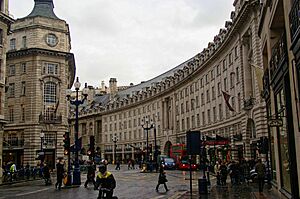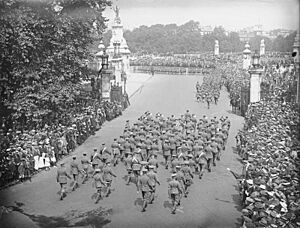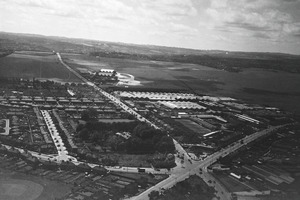History of London (1900–1939) facts for kids
London, the capital city of England, was a very important place at the start of the 20th century. It was the center of the largest empire in history! From about 1825 until 1925, London was the biggest city in the world, before New York City became larger. This article looks at London's history from 1900 until World War II began in 1939. During these years, London faced many new challenges and changes.
Contents
Edwardian London (1901-1914)
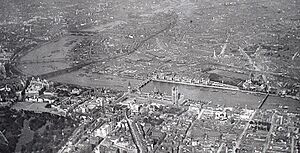
The years between Queen Victoria's death in 1901 and the start of World War I in 1914 were a time of growth and wealth for London. However, there was still a lot of unfairness, with many people living in poverty. By 1900, about one out of every five people in Britain lived in London. The city's population grew from around 5 million in 1900 to over 7 million by 1911.
During this time, London was a key place for the Women's Suffrage movement. This movement fought for women's right to vote. Emmeline Pankhurst and her group, the Women's Social and Political Union (W.S.P.U.), moved their main office to London in 1906. They wanted to put more pressure on the country's leaders. London had the most support for the W.S.P.U. in the UK, with 34 of its 90 offices located there.
Protests and demonstrations became more intense, especially between 1912 and 1914. Hyde Park hosted two big rallies in 1908 and 1913. The first one had over 250,000 people! London was also where important events like Black Friday happened. During this event, a march from Caxton Hall to the Palace of Westminster led to fights with the police, resulting in many arrests and some deaths.
Buildings and Architecture
Many buildings in Central London were rebuilt during the Edwardian years. They were often in styles like Beaux-Arts and Edwardian Baroque. A lot of this building work was slowed down by World War I (1914-1918) and finished in the 1920s.
Important government buildings built then included County Hall (1911–22), the War Office (1906), and the Port of London Authority Building (1912–1922). The old buildings of John Nash's Regent Street, built in the 1820s, were completely rebuilt between 1905 and 1927. The simpler Regency buildings were replaced with grand new shops and offices made of Portland Stone. This changed the look of the West End. The Mall was also made into a grand parade route for royal events. This included building Admiralty Arch (1911), updating Buckingham Palace (1911–1912), and putting up the Victoria Memorial (1911).
In Holborn, a poor area called Clare Market was torn down to make way for Kingsway (1905). This was a wide street with an underground tram tunnel. Aldwych, a curved road connecting Kingsway with The Strand, got new theaters, hotels, and buildings like Australia House (1913-1918).
Transport Improvements
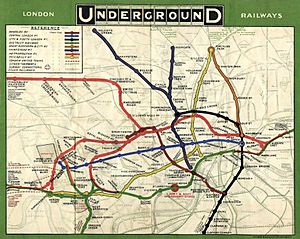
The Edwardian period saw a huge expansion of the London Underground. This was possible because of new electric trains, deep tunnels, and money from the United States. Four new deep underground lines opened between 1900 and 1907. Older lines were also extended and made electric.
The Central London Railway (now the Central Line) opened on July 30, 1900. It first ran from Bank to Shepherd's Bush. In 1908, it was extended to White City for a big exhibition and the 1908 Summer Olympics. The Metropolitan Railway and District Railway were extended west to Ruislip and Uxbridge in 1904. They started using electric trains in 1905.
In 1906, the Baker Street and Waterloo Railway (now the Bakerloo line) opened. In December, the Great Northern, Piccadilly and Brompton Railway (now the Piccadilly line) also opened. In 1907, the Charing Cross, Euston and Hampstead Railway (CCE&HR) opened, running through North London. Many of the stations from this time were designed by Leslie Green. They are easy to spot with their round windows, red brick, and green-tiled ticket halls.
Most of the new underground lines were owned by the Underground Electric Railways Company of London (UERL). This company grew by buying other underground lines, as well as bus and tram companies. By 1913, only London's oldest line, the Metropolitan Railway, and the Waterloo & City line were not controlled by the UERL. Even with competition, these companies worked together in 1908. They united the whole network as the "Underground" for advertising, signs, maps, and tickets.
Life in Poverty
Reports from this time showed how hard life was for many poor Londoners. One report from 1909 found that one-third of the 900,000 people in the East End lived in extreme poverty. These areas were very crowded and dirty. On average, 25 houses shared one toilet and one fresh-water tap. To help with the lack of cleanliness, public washhouses were built for bathing and washing clothes. In 1910, about 60,000 people used these 50 bathhouses every week.
Charles Booth's detailed study, Life and Labour of the People of London, also showed how tough conditions were. Throughout the early 20th century, the London County Council worked to clear slums and build "model dwellings" in poor areas like Spitalfields and Whitechapel. While living conditions improved, about 8.7% of London's population was still poor in the late 1920s. This number rose to about 10% in 1934 because of the Great Depression.
Poor Londoners lived in crowded, unhealthy slums. Meanwhile, middle-class families moved to the growing suburbs for fresh air and more space. People born in London's slums often looked unhealthy and weak. During the Boer War (1899–1902), it was found that 7 out of 9 working-class Londoners were not healthy enough for military service. An American writer, Jack London, wrote in 1903 that the poor air and conditions in London's slums made people weak and unable to compete with healthier people from the countryside.
World War I (1914-1918)
During World War I, London experienced its first ever bombing raids. These attacks were carried out by German zeppelin airships and later by airplanes. On May 31, 1915, a zeppelin dropped bombs over the East End and the docks, killing seven people. There were ten more airship raids over London in 1915 and 1916, and one more in 1917.
By 1917, British forces became better at shooting down airships. So, the German military started using airplanes to attack London instead. The first attack by bombers happened in May 1916. On June 13, 1917, the largest World War I air raid on London took place. Fourteen Gotha bombers attacked many places in the City and East End, causing about 160 deaths. More raids followed in 1917 and 1918. However, by May 1918, British air defenses had improved so much that Germany stopped the raids.
These air raids killed around 670 people and injured 1,960. They caused a lot of fear among Londoners. But the biggest impact was the number of Londoners who died fighting in the war: about 124,000 young men never came home.
The largest explosion in London's history, the Silvertown explosion, also happened during World War I. A factory storing 50 tons of TNT exploded, killing 73 people and injuring 400.
London in the 1920s and 1930s
City Growth
The early 20th century, especially the years between the two World Wars (1920s and 1930s), saw London's urban area grow faster than ever before. Most of this growth was suburban expansion into nearby counties like Essex, Hertfordshire, Kent, Middlesex, and Surrey. Londoners started preferring lower-density suburban homes, often semi-detached houses, looking for a more "rural" lifestyle. This was different from the older preference for terraced houses. This rapid growth swallowed up large areas of countryside. Concerns about losing green spaces eventually led to the creation of the Metropolitan Green Belt, which limits urban growth.
London grew beyond the borders of the County of London. This led to calls for a single "Greater London" authority to cover the whole urban area. However, this idea was rejected in 1921.
London's urban population reached its highest point of about 8.6 million in 1939. All of this growth happened outside the old County of London borders. The population within the County of London actually fell from 4.5 million to 4 million during these years.
Many Jewish immigrants, escaping Nazi Germany, settled in London during the 1930s, mostly in the West End.
High-rise Buildings
There were big discussions in the 1920s and 1930s about building tall apartment blocks for social housing. Some people were very keen on them, while others strongly opposed them. Those on the political left called them "barracks for the working classes." But reformers on the right thought tall buildings were a good way to solve overcrowding and high rents. As a result, new ideas for city living were tried, especially in slum clearance projects. These often aimed to replace unhealthy slums with high-rise blocks that had lifts. Examples in the Metropolitan Borough of Stepney included John Scurr House (built 1936–1937) and Riverside Mansions (1925–1928).
Architecture and Building
As the suburbs grew rapidly, Central London spent much of the 1920s finishing big construction projects that had been delayed by World War I. A new trend in the 1920s and 1930s was the sale of many of London's grandest private homes in wealthy areas like Mayfair and St. James's. Rich families could no longer afford to keep these large houses because of rising taxes. So, they sold them to developers who built new shops and homes. This trend sped up when the Great Depression began in the 1930s. Famous examples include Grosvenor House and Dorchester House on Park Lane, which became luxury hotels.
After an exhibition of Art Deco architecture in Paris in 1925, London architects eagerly adopted this new, sleek style. Art Deco became the main style for new buildings in London through the late 1930s. It looked modern and fresh, unlike London's common Victorian buildings. Major examples built then include media headquarters on Fleet Street, like the Daily Telegraph building (1928) and the Daily Express Building (1932). Also, BBC Broadcasting House on Langham Place was built. The style was also great for large industrial buildings like Battersea Power Station (1934), the Hoover Building (1932–37), and the Carreras Cigarette Factory. Other amazing Art Deco buildings are Ideal House in the City of London, and Senate House, the 19-story headquarters of the University of London in Bloomsbury.
Transport Expansion
London's fast growth during this time was helped by a quick expansion and update of its transport systems. The London County Council built a large tram network. The first motorbus service also started in the early 1900s.
Many of London's commuter railways became electric during the years between the wars, mostly thanks to the Southern Railway. The London Underground system also grew beyond London's northern suburbs. This encouraged the fast development of new outer suburbs in areas like Hendon and Edgware. In 1926, the CCE&HR line joined with the City and South London Railway, creating the Northern line. In 1933, the London Passenger Transport Board was created to manage transport across a large part of south-east England. The road network was also updated with new main roads built in the 1920s.
Major building projects were finished during these years. The most important was the expansion of the Port of London docks. This included the King George V Dock, which increased capacity by 10%. Existing docks were made deeper and larger to fit bigger ships. The deep-water port of Tilbury on the Thames Estuary was also expanded.
In 1920, two airfields from World War I were combined to create London's first international airport, Croydon Airport. This was London's only international airport until after World War II. From Croydon Airport, Britain's first airline for long-distance flights, Imperial Airways, started its network across the British Empire. This began in 1925 with flights to Cairo and Karachi. By 1932, regular flights were set up from London to far-off parts of the British Empire like Singapore, Hong Kong, and Cape Town.
London's Economy

Before World War I, Britain was the world's leading economic power. However, the war had a huge impact on the economy. While London stayed quite wealthy compared to the rest of Britain during the years between the wars, its economy still saw some decline. One big reason London remained relatively strong was its population growth. London's population grew from 7.25 million in 1911 to 8.73 million in 1939. Another factor was the "Pax Britannica," a period of British peace, which brought more shipping, imports, and investments.
The war created a massive economic demand. Britain spent over £3.25 billion from 1914 to 1918. The government took steps to raise money and boost the economy. They increased taxes on property and income, took out large international loans, and printed more money. These actions helped Britain's economy, but London still faced rising unemployment. The city's workforce had to change. For example, the unemployment rate for insured workers in London went from 7% to 10% in just one month in 1914.
A major reason unemployment didn't get too high was the big increase in women joining the workforce. While many women worked before the war, their numbers kept rising. Women's employment went from 23.6% of the working-age population in 1914 to between 37.7% and 46.7% in 1918. The biggest employer of women was the munitions industry, which made weapons and shells. By 1917, these factories made 80% of all weapons used by the British Army. Even though women played a huge role in the economy, they only earned about two-thirds of what men earned for the same jobs. After the war, there was a short economic boom from 1919 to 1920, as people wanted to buy things they couldn't during the war.
London managed to avoid the worst effects of the Great Depression (1929-1939). While most parts of the UK faced rising unemployment and poverty, London's unemployment rate was only 5.6%. Areas that relied heavily on big industries, like Northern Ireland, Scotland, and Wales, were hit the hardest. London, however, had less heavy industry and was more involved in lighter industries, such as chemicals, electrical goods, and cars.
Politics in London
For many years, the London County Council (LCC) was controlled by either the Progressive Party (linked to the Liberal Party) or the Municipal Reform Party (linked to the Conservative Party).
In 1934, the Labour Party, led by Herbert Morrison, won control of the LCC for the first time. The Labour Party would then lead the council until it was replaced by the Greater London Council in 1965. Herbert Morrison was a very important figure in local government during the 1920s and 1930s. He became mayor of Hackney and a member of the LCC in 1922. He also served as Minister of Transport for a while. When Labour took power in London in 1934, Morrison brought together the bus, tram, and underground services by creating the London Passenger Transport Board (known as London Transport) in 1933. He also led the project to fund and build the new Waterloo Bridge. He helped design the Metropolitan Green Belt around the suburbs and worked to clear slums, build schools, and improve public assistance.
In the East End during the 1930s, different political groups gained support. The Communist Party of Great Britain won a seat in Parliament, and the British Union of Fascists also had many supporters. These groups sometimes clashed, leading to events like the Battle of Cable Street in 1936.
See also


